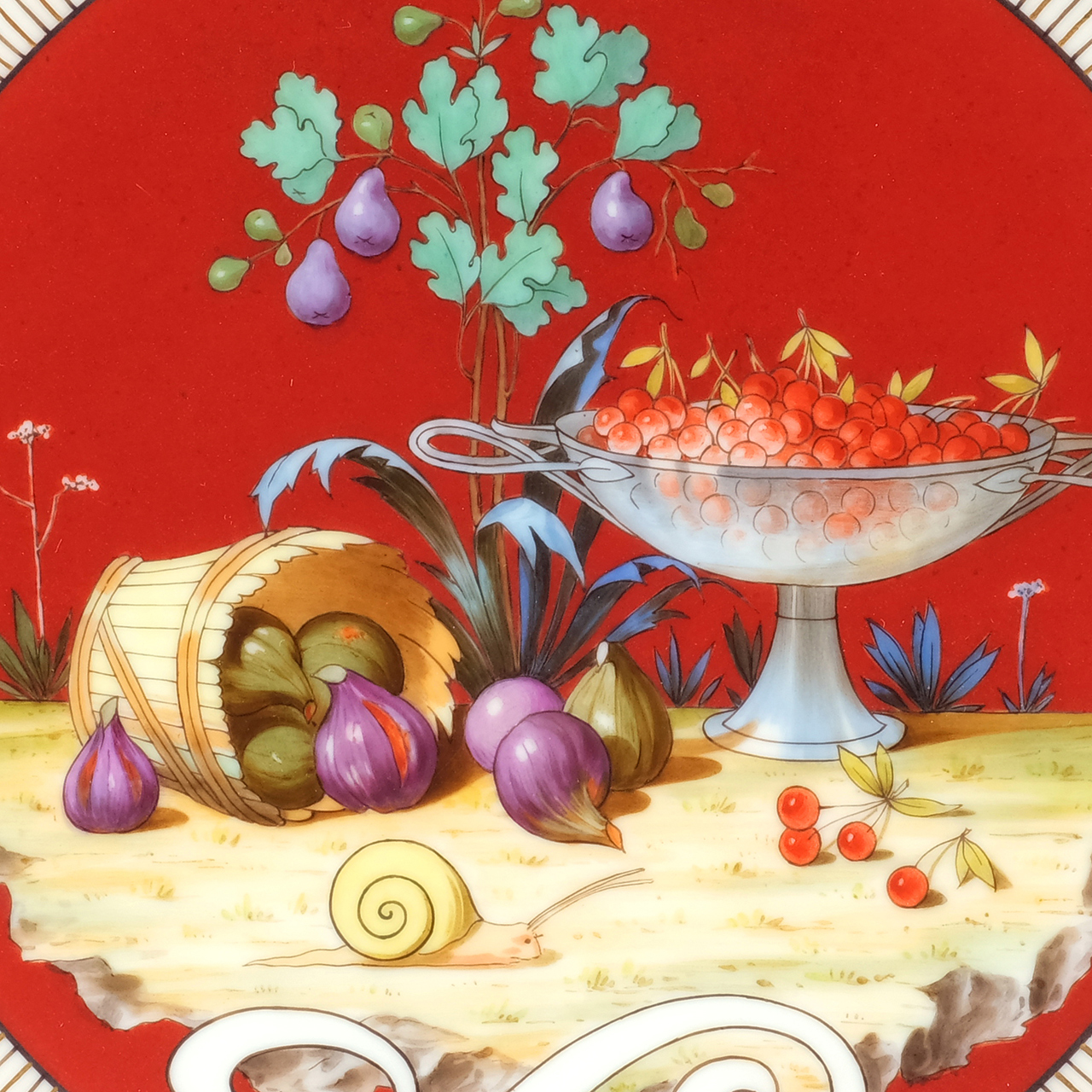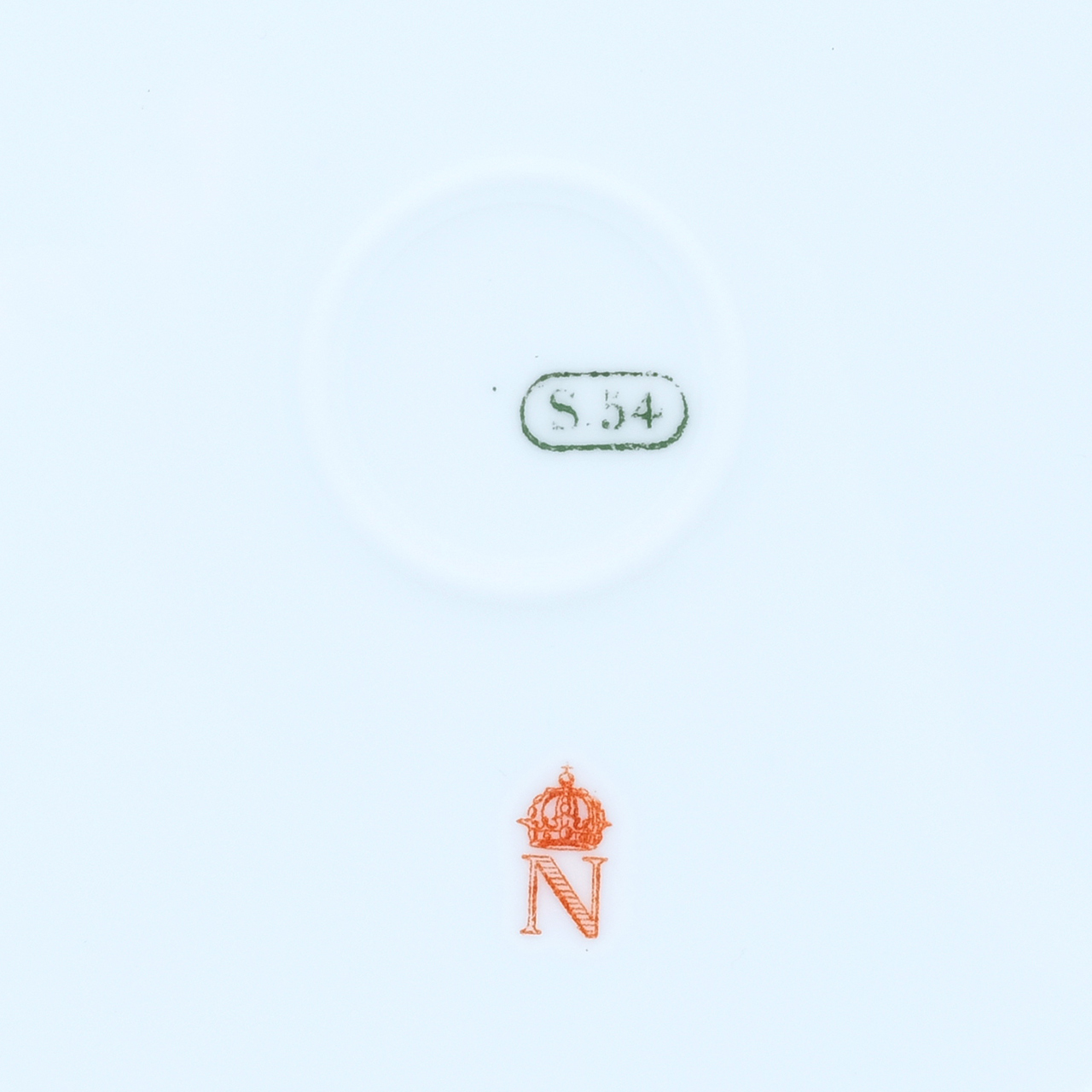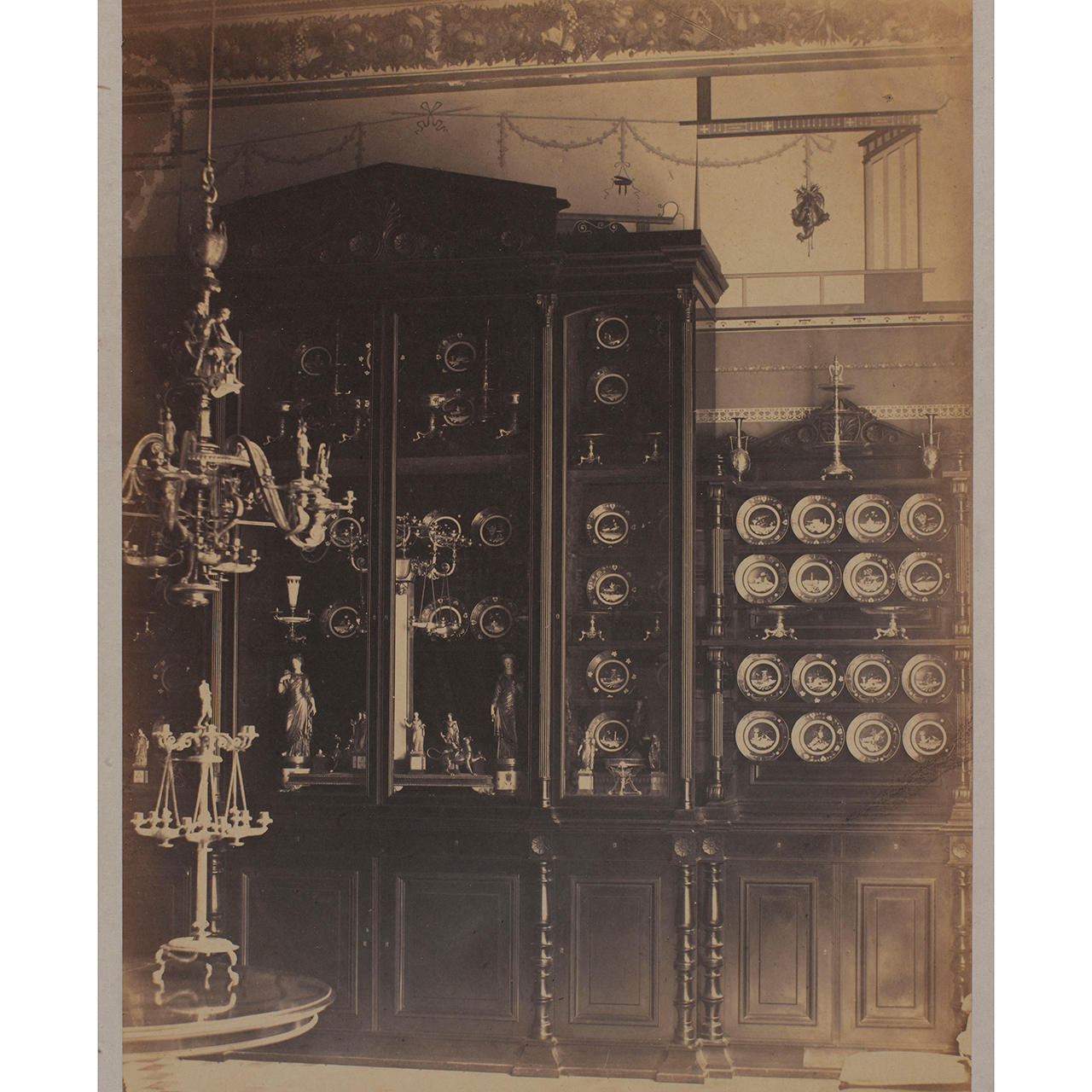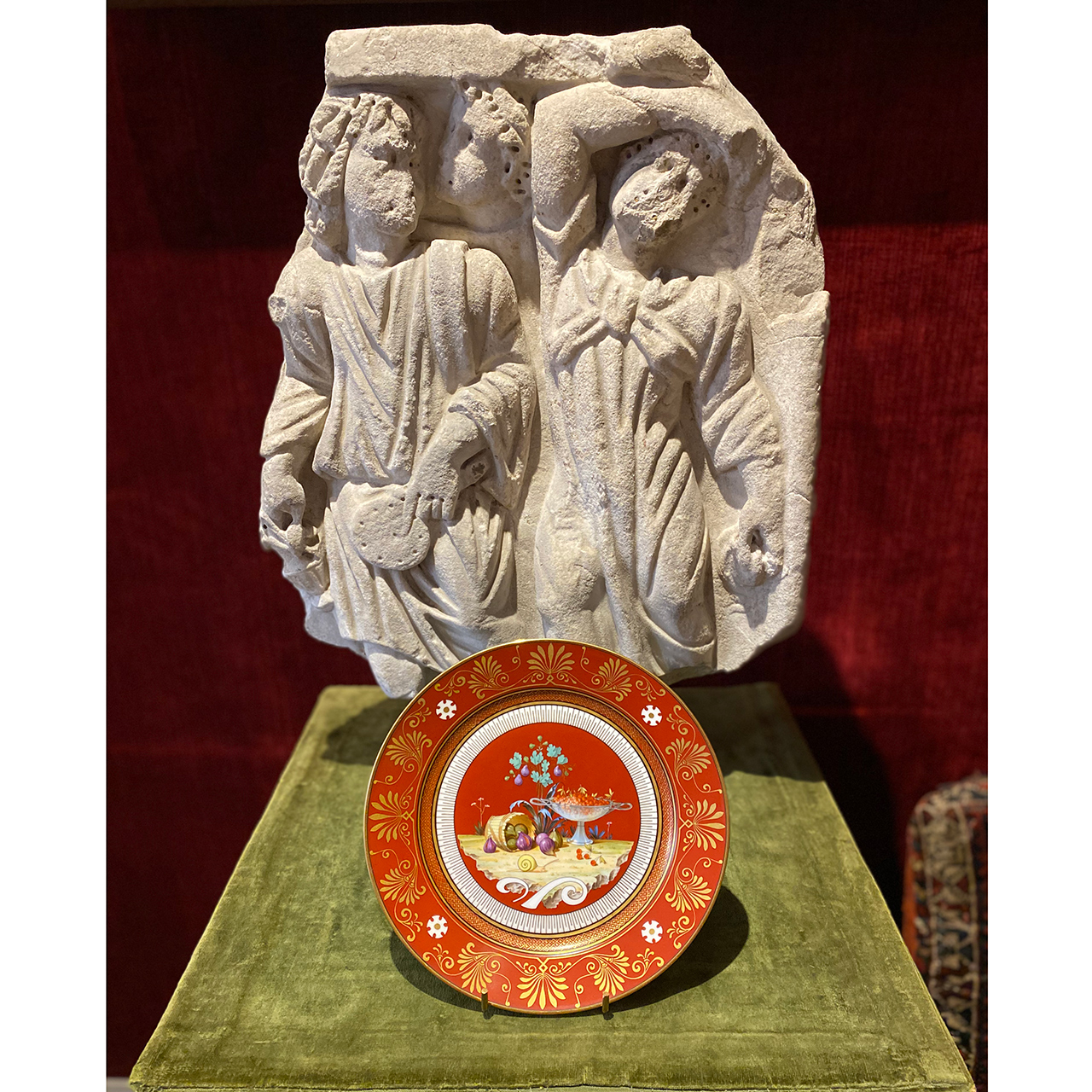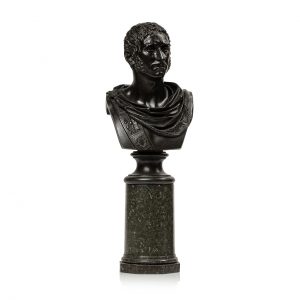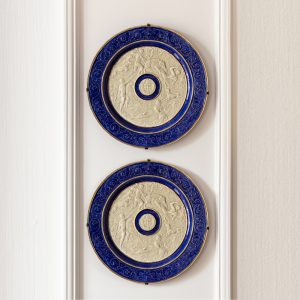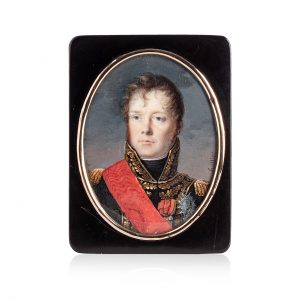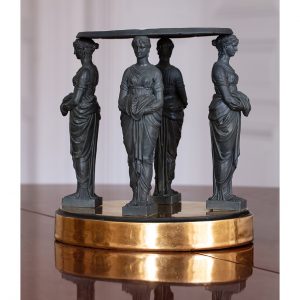Hard-paste porcelain plate, with a matt red ground called "Pompeian red", the marli decorated with stylized gold palmettes and flowered reserves left white, the center with polychrome decoration of a still life with figs and cherries in an antique glass bowl with a snail in the foreground, inspired by the frescoes of Pompeii.
Perfect condition.
Sèvres Imperial Factory, circa 1854-1856.
Mark with crowned N with red stamp without date.
Mark of the green stamp dated S. (18) 54.
Incised mark dated July 1854.
D. 24 cm.
One of the 72 plates from the service delivered to His Imperial Highness the Prince Jérôme Napoléon (1822-1891) on March 23, 1857, for his Pompeian Palace in Paris.
A double starter and dessert set with "Etruscan decor" was ordered from 1854 to harmoniously match Prince Napoleon's Pompeian villa (see below). It entered the Sèvres sales store in October 1856 (Arch. Sèvres, Vv6, 24-37 to 46 and 24-47) and was delivered to S.A.I. Prince Napoleon on March 23, 1857 (Vz9, 58 v°). The entry with "Etruscan frieze in gold" consisted in particular of 120 flat plates (at 9 frs / piece) and a series of shaped pieces; the dessert, consisting essentially of 72 flat plates (at 76 frs / piece) and coffee and tea cups, was called "service with a red-brown background, Etruscan decoration in gold, significant trophies in the center".
These central scenes were drawn by Jules Dieterle (1811-1889), director of art works in Sèvres and having supervised the service, and were painted by five ornamentalists, including Gérard Derichweiler (1822-1890), and a gilder.
Younger son of Jérôme Bonaparte, former King of Westphalia, and Catherine of Württemberg, Prince Napoleon, known colloquially as “Plon-Plon”, was born in exile in Trieste. He is the brother of Princess Mathilde. On the death of his mother in 1835, he was welcomed by his aunt Hortense in Arenenberg, where he befriended his first cousin Louis-Napoléon, future Emperor Napoleon III. Unbeknownst to his cousin, he has an affair with the famous tragedian Rachel, of whom Louis-Napoléon is also the lover. He has the use of the Palais-Royal and the castle of Meudon, allocated to his father by Napoleon III. In 1854, he also decided to have a neo-Pompeian style mansion built on Avenue Montaigne, following the tastes of his then mistress. It is probably for her that he ordered this service "red background, Etruscan decoration" at the Manufacture de Sèvres, Arsène Houssaye, director of the Comédie Française, quotes in fact: "Miss Rachel even has a service representing all the figures of antique frescoes "(in Les confessions, souvenirs d'un demi-siècle 1830-1880, 1885, vol. IV, p. 243).
Plon-Plon fell out of favor in 1865 after delivering a speech in favor of a liberal empire during the inauguration of a monument in Ajaccio on May 15. He then retired to his property in Prangins, on the shores of Lake Geneva.
Sometimes called the Pompeian Palace, the mansion of Prince Jérôme Napoléon in Paris in the style of the Villa of Diomedes in Pompeii was located at 16-18 avenue Montaigne between 1860 and 1891. It was built between 1856 and 1860 on the old site of the Pavilion of Fine Arts of the Universal Exhibition of 1855. As president of the Exposition, Jérôme had bought the land for this purpose, in order to please his mistress, the tragedian Rachel, by building a palace for her. reminiscent of the villas of Pompeii. The architects included Jacques-Ignace Hittorff, Auguste Rougévin and Alfred-Nicolas Normand. Camille-Auguste Gastine created the decorative patterns in the Pompeian style. His interior paintings included works by Sébastien Cournu and Jean-Léon Gérôme. It is considered a sublime example of the Greek Revival style.
Rachel died in 1858 and never saw the end of the work. Jérôme, married in 1859 to Marie-Clotilde de Savoie, holds "antique" parties there where presentations of texts or plays are given by popular actors. The plates were displayed in wall cabinets and sideboards in the dining room. When Jérôme went into exile, he sold it to a group of investors who opened it to the public during the Universal Exhibition of 1867. Abandoned during the siege of 1871 and in poor condition in 1889, it was demolished in 1891, making our plate is a rare witness to the taste for the Pompeian imagination, evocative of a reinvented archeology.
- Three plates are in the collection of Count Charles-André Colonna Walewski, on deposit at the Second Empire Museum, Château de Compiègne (purchased at auction in Versailles on October 14, 2012).
- Eight plates are kept at the Cité de la Céramique, Sèvres (inv. MNC 26640 to 26647), purchased in 1992-1993.
- A plate is kept in the British Museum, London (inv. 1992.0709.1), purchased in 1992.
- Two plates went on sale in London, June 19, 1996.
- Aileen Dawson, French porcelain. A catalog of the British Museum collection, 1994, cat. 189, p. 230-232.
- Marie-Noëlle Pinot de Villechenon, The "Pompeian" service in Sevres porcelain from Prince Jérôme Napoléon or a new fortune in Pompeian ceramic decoration, Revue des Musées de France, n° 5-6, 1997, p. 72-77.
- Cat. exp., Spectaculaire Second Empire, Musée d'Orsay, Paris, ed. Skira, 2016, cat. 150 p. 153-156.



